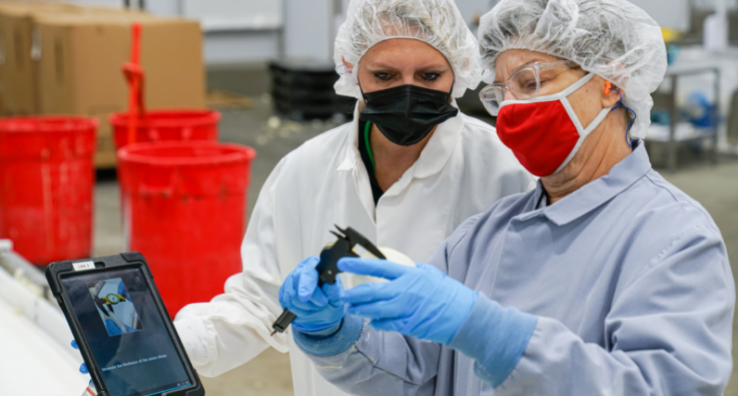Keeping Food Safe During an Interrupted Supply Chain

When most people talk about their experiences around supply chain interruptions, it’s usually about goods and materials that they rely on at home or for work, whether it’s patio furniture, laptop computers, or toilet paper. Nearly everything has been delayed as the world struggles to work through a historically crippled supply chain.
But most consumers don’t understand how it challenges the processing and manufacturing of the foods that we eat every day and the potential impact on the safety of that food. It’s more than what foods are on grocery store shelves. It’s about the safety of those foods.
Anyone who wants to know how hard it is to keep foods safe during this supply chain breakdown needs only look at the ingredients for a frozen pizza or a can of soup. Delays in any one of the ingredients or packaging can disrupt production schedules, delay shipments and cause empty retail shelves.
As manufacturers cope with these very real challenges, they often have to quickly identify new suppliers or change processes and formulas. That’s where potential shortcuts can arise and pose significant risks to consumers and food recalls.
An interrupted supply chain can have a real domino effect on the safety and quality of our foods. For example, if it takes 12 ingredients to make a frozen pizza and two of those are delayed or can’t be delivered, that pizza manufacturer has to jump to plan B to find a new replacement vendor in short order.
Food processors and manufacturers can reduce their risks when faced with supply chain disruptions with components of a strong supply chain resilience, including multi-sourced vendors, strong food safety vendor audit programs, robust vendor communications, detailed product specifications, and vendor expectations, and effective change management skills.
Unfortunately, not all companies have invested in these components. For example, a quickly sourced new ingredient supplier might be able to deliver a similar ingredient but, under close examination, have a slightly different product specification that introduces a new/unexpected allergen. This is when we see the potential for undeclared allergens resulting in a food recall. It’s hard to fathom the interdependencies within the global supply chain.
Given these challenges, here are three ways to minimize delays and reduce your risks when the supply chain interrupts your production.
Examine Suppliers and Their Specifications
When onboarding a new supplier, every manufacturer should review the supplier’s detailed product specifications, which will inform the technical and functional aspects of the product.
Detailed specifications should include:
- Production methods, ingredients, package size, shelf life, coding, storage and transportation
- Sensory properties
- Nutritional values
- Declaration of allergens
- Microbiological limits
- Chemical physical properties
- Labelling
- Quality properties
- Certificates (if applicable)
- Regulatory compliance
As a best practice, manufacturers should ask for a copy of their recent GFSI food safety audits or equivalent and proof of liability insurance.
A careful review of the vendor’s product specification ensures that this newly sourced ingredient meets your purchase expectations, label requirements, and food safety and quality risk profile. Given how quickly an interruption can occur, it’s best to establish your new vendor expectations and develop a supplier questionnaire. And always plan ahead by sourcing multiple backup suppliers prior to ingredient and packaging disruptions.
A great example of this approach can be seen in Walmart’s supplier requirements and questionnaire.
Use Employees as the Ultimate Line of Defense
Intertek Alchemy stresses that employees can be the first, last, and best defense against food safety threats. This is especially true now as supply chain issues introduce new threats and anomalies.
Food manufacturers should train employees on how to spot and report anything that doesn’t look or smell right. For example, the receiver should notice that the spices coming into the warehouse might be arriving from a different production location or lack the proper certifications. Employees in the batching room should notice the new spices have a different texture or color that could impede processing or affect product quality attributes.
Whatever the issue, frontline employees need the authority and the autonomy to say something to their supervisor when they see something different or unexpected. It’s critical to train employees to know they share the responsibility to ensure the safety and quality of the products they produce.
Train your employees to know what acceptable ingredients and products look like and encourage them to sound the alarm when they see something that is doesn’t look acceptable. Harnessing the eyes of all your employees as your ultimate quality control team will help prevent costly recalls, product rework and further production delays
Check Supplier Labels
It’s important always to compare the label to the product specification to ensure it is compliant and expected. When a package arrives on the dock, receivers need to know if the contracted product has arrived as specified. Is the product packaged correctly, within expected shelf life, in a sanitary condition? Look for inconsistencies per pallet with lot codes and shelf life.
Employees should check the condition of incoming products for unusual odors or colors that might not seem right or for packaging that looks different from prior shipments.
All of this might seem like a lot of extra work and attention tied to the pandemic and supply chain, but it’s something we should all be doing all the time as part of a mature food safety culture.
If you’ve changed the way you maintain food safety and quality during all the supply chain disruptions, we’d love to hear about it. Just leave it in the message section below. Likewise, if you need help creating supply chain resilience, supplier questionnaires, product specification templates, or help training your employees to identify and report issues, contact us for a free consultation.





